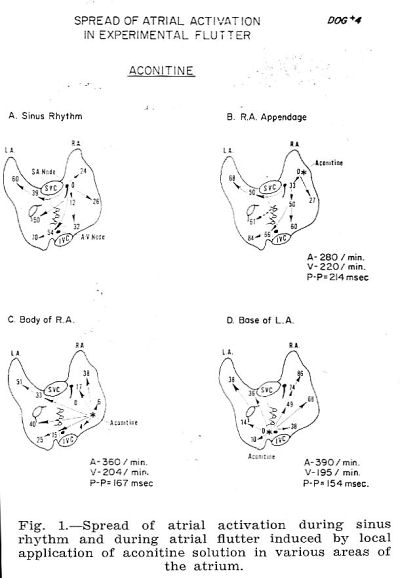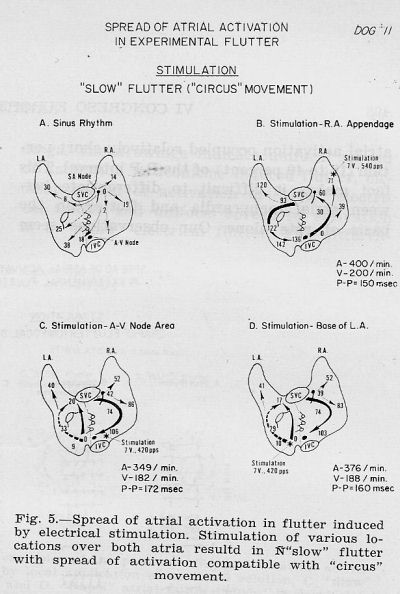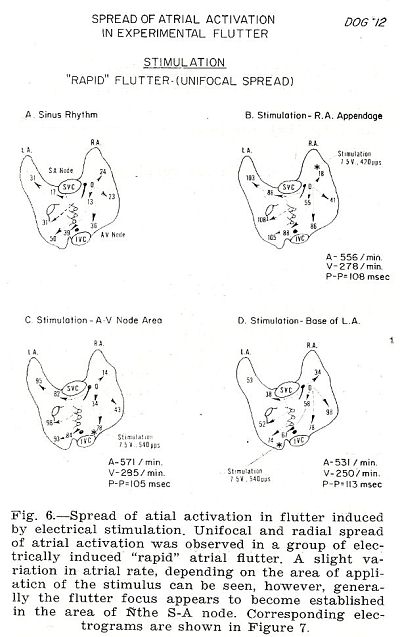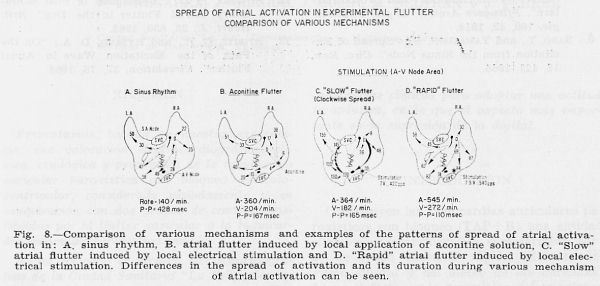|
Summary
Two theories of spread of electrical activation in atrial flutter have
been proposed in the past and both of them found their supporters (and
deniers) based on experimental studies and clinical observations. They
are: 1. unifocal origin with radial spread of
activation from a rapidly firing single focus and 2. circus
movement, i.e. activation spreading in a circular fashion
around the central obstacle (the focus initiating this circular
movement has not been established). In earlier experiments,
aconitine was applied topically and more recently
electrical stimulation was used.
In
our experiments, atrial flutter was produced in 16 large mongrel dogs
by local application of aconitine or by electrical
stimulation. Atrial electrograms were recorded with five
bipolar electrodes attached to each atrium. Approximately 300
paroxysms were produced using both methods. Two distinct responses
were observed:
1. Aconitine
produced atrial tachycardia (or flutter?) with atrial rates ranging
from 200 per minute to 440 per minute with radial spread of
atrial activation from one focus (the area of local
application). Atrial activation occupied from approximately 15 to 50
percent of the P-P interval.
2. Electrical
stimulation
produced two major types of activation patterns:
a. Unifocal radial spread
of atrial activation was observed in one distinct group, which
included "rapid" ectopic atrial rhythms (flutter) with rates between
480 and 570 per minute. Atrial activation appeared to initiate most of
the time in the area of the S-A node regardless of the location of the
stimulating electrode and stimulus parameters.
b. Spread of
activation compatible with the so-called circus movement, in a
caudad direction over the right atrium and in a cephalad direction
over the left atrium (or sometimes reversed) was observed in "slow"
ectopic atrial rhythms (flutter) with rates from 350 to 400 per
minute. Activation of ectopic foci in the area of the A-V node and the
S-A node is a possibility.
Atrial activation in electrically induced atrial flutter occupied from
approximately 70 to 95 percent, and on occasion even more, of the P-P
interval with the right atrium accounting for approximately 60 to 80
percent of the atrial activation time.




Publication:
1. New Evidence of Dual
Mechanism of Electrical Activation in Experimentally Induced Atrial
Flutter. Waldemar J. Wajszczuk, M.D., F.A.C.C. and Elliot Corday,
M.D., F.A.C.C. Actas del VI Congreso Europeo de Cardiologia,
Madrid, Spain, 1972, (Published by Editorial Paz Montalvo, Madrid,
1974). |